English 2122 (British Literature 2)

Class Time: MW 11-1215
Professor: Matthew Silverman
Office: Russell Hall Room 215
Office Hours: MTWTH 830-930, T 1-2, TH 11-2 & 330-430
Email: msilverman@gordonstate.edu
Phone: 678-359-5069 (office)
478-832-0056 (cell, prefer texts)
for English 2122:
Remind
#81010, class code @mes2122
*Tentative
schedule and subject to change*
Grading Policy:
Quizzes and homework (I drop the lowest grade of these)
20%
Midterm
20%
Final (Response Essay)
15%
Response Essay (1-2 pages)
20%
Creative media Project
on 1 Victorian Author with Response Paragraph
25%
Student Success Center (SSC)
The Gordon State College Success Center is committed to helping students achieve
academic and personal success. Our mission is to support students at any level
and of any ability in their course work and in the development of personal
skills that will help them achieve their academic and life goals.
SSC Tutoring Hours:
Monday – Thursday 8-5
Friday 8 - 3
Harry’s House (Food Pantry)
If you know a student in need of food and other needs, please have them check
out Harry’s House located in the SSC Room 212. Their mission is to distribute
food and toiletries to students to alleviate stress associated with short term
food shortages. For more information and an application:
https://www.gordonstate.edu/student-life/health-recreation/counseling/harrys-house/index.html
Harry’s House Hours
Tuesday &
Wednesday
8:30-9:30AM & 3:30-4:30PM
Counseling & Accessibility Services
If you know a student in need of this, please have them contact these services.
It does not go on a transcript and it is completely private. It is located in
the SSC Room 212. Their phone number is 678-359-5585. After hour
emergencies is 678-359-5111.
Counseling Hours
Monday – Friday 8-5
Required Texts:
Greeblatt, Stephens, gen. ed. The Norton Anthology of English Literature,
Volume 2. 10th edition.
New York, Norton, 2012.
(You may have Volume D, E, and F instead marked as The Romantic Period, The
Victorian Age, The Twentieth and Twenty-first Centuries)
Don’t know if this works but I think the 8th edition is free online:
https://archive.org/details/TheNortonAnthologyOfEnglishLiteratureVol.2
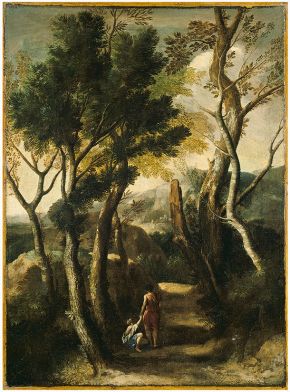 "Italian
Landscape" by Gaspard Dughut
"Italian
Landscape" by Gaspard Dughut
M 8-19
Romanticism Era Music: Fantasie Impromptu Op. 66 by Fryderyk Chopin:
https://youtu.be/Gy5UHK4EeM8
(Orchestral music becomes more emotional and subjective like
poetry. Composers inspired by romantic love, the supernatural and even dark
themes such as death, drawing inspiration from history and folk songs. Piano
still main instrument but orchestra instruments expanded.)
Name Tag Create
(brief) Syllabus review
Brief Introduction to Romanticism (PowerPoint Slides #1-12)
How and Why we Read:
https://www.youtube.com/watch?v=MSYw502dJNY&list=PL8dPuuaLjXtOeEc9ME62zTfqc0h6Pe8vb
Hmwk: review syllabus for quiz, read Introduction pages 3-22

NO SHAME THEATRE*:
Wednesday, August 21st at 6:30pm, Fine Arts Theatre
You can watch OR you can come and perform...ANYTHING. The choice is yours!
3 RULES
1 - Must be original work. (spoken word, dance, poetry, scenes, improv,
music...anything, as long as you created it)
2 - Must be 5 minutes or less
3 - Must not break the law
W 8-21 (Lord Byron: pages 608-611, 613)
Romanticism Era Music: Chopin (Perhaps most famous Romantic composer!)
Waltz in D-flat major, Op.
64, No. 1 (Minute Waltz)
Overview of Romanticism (6 min):
https://www.youtube.com/watch?v=k9Ebl_MxbYw
Quiz 1 on syllabus
Lord Byron: “She Walks in Beauty” pg 613 & “Childe Harold's Pilgrimage” (found in PowerPoint
or online) & “When
We Two Parted”
Introduction to Romanticism (PowerPoint slides #29-46)
Get started on homework in groups [we will use Lord Byron “When
We Two Parted”
(love poem not in book) since some people dont have book yet to
discuss & begin One Sentence Assignment]
Different animation projects of Byron's "She Walks in Beauty"
cartoon splice:
https://www.youtube.com/watch?v=xyRBYkzylbU
powtoons:
https://www.youtube.com/watch?v=wI99ZhdMbqw
different people reciting:
https://www.youtube.com/watch?v=R2zSt--pJ-o
Mahler Music & Old Hollywood Photos:
https://www.youtube.com/watch?v=Oh81uGnkMqg
Funimation:
https://www.youtube.com/watch?v=M2hc4RHXFUw
Hmwk: One sentence Assignment (2 at the most!): Pick a poem not on the syllabus
but in the textbook and write about it in one sentence. For example, “Kubla
Khan” by Samuel Taylor Coleridge is a poem about a very imaginative and
dream-like adventure that has become one of the most famous poems in the 19th
Century.” Or it can be about how you feel after reading the poem like
“Coleridge’s poem, “Kublah Khan” seemed unusual and dream-like but it felt like
a place I wanted to visit with it’s focus on beautiful images of nature.”
Suggestions (you can choose another): Anna Letitia Barbauld “The Caterpillar” pg
53 or “Washing Day” pg 51, Mary Robinson “The Haunted Beach” pg 85, Robert Burns
“A Red, Red Rose” pg 191, Lord Byron “When
We Two Parted”
(love poem not in book)
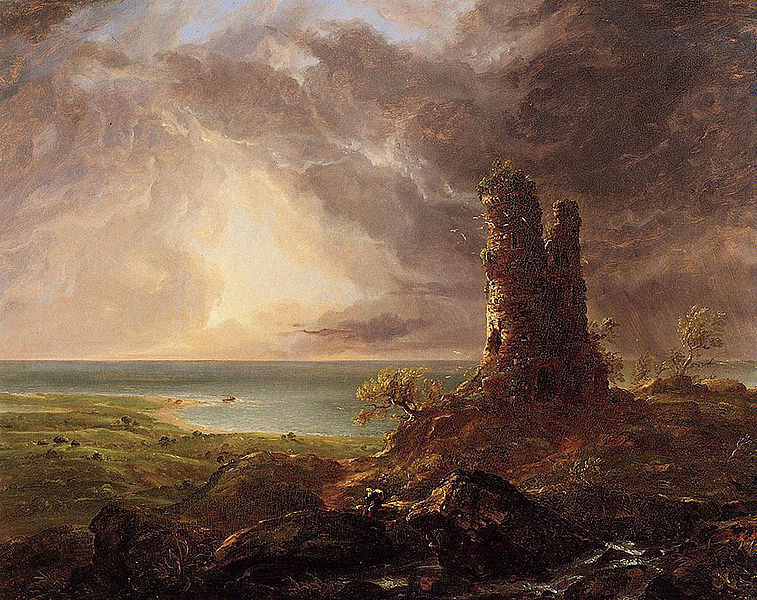 "Romantic
Landscape with Ruined Tower" by Thomas Cole
"Romantic
Landscape with Ruined Tower" by Thomas Cole
M 8-26
Romanticism Era Music:
Tchaikovsky 1812 Overture
(William Blake, pg 122-125, 138, 139-140)
One Sentence Assignment Due (Quiz 2)
Slightly funnier overview of Romanticism (9 min):
https://www.youtube.com/watch?v=xqQKwJvFGYI
Introduction to Romanticism (PowerPoint Slides #13-18)
William Blake “The Sick Rose”: Analysis (8 min):
Hmwk:
"What is a Poet" pages 310-314
(Wordworth)
Creative Visuals on Blake’s “Tygre” (Did they get the fire image right or
wrong?):
Professionally done with Bach's Cello Suite No. 5 in C minor:
https://www.youtube.com/watch?v=oF9kbTedTL8
an award winning animation by Radheya Jegatheva:
https://www.youtube.com/watch?v=AUqowAVgZxA
a college student art animation creation:
https://www.youtube.com/watch?v=le5I9SZUQ6U
 "The
Fall of the Rhine at Schaffhausen" by Philippe Jacques De Loutherbourg
"The
Fall of the Rhine at Schaffhausen" by Philippe Jacques De Loutherbourg
W 8-28 (Response Paper Review Day & WordCloud Review)
Review Response Paper requirements and
optional outline,
rubric, and samples
Review "What is a Poet" by Wordsworth pg 310-314
(Can compare this to
John Stuart Mill's "What is Poetry?" pg 74-81 from Victorian book)
Hmwk: Pick one writer and create Word
Cloud. Focus on their life. You can find all the information you need at the
beginning section of each poet. For example, William Blake can be found on pages
122-125. However, try a writer we have not gone over yet like all the wonderful
female writers! Look in Table of Contents! You will need to turn in
Word Cloud
either by printing it or emailing it and don’t forget to turn in a list
of the facts/information/quotes/famous works you discovered. Min
10 things about the writer
that you included in the Word Cloud.
These two things will be due next class! (If you never used this software
before. Try clicking WIZARD on right side of the bars. One
feature I find helpful is to use the SHAPE button to create
your shape once you have your word cloud created, so do that last! Play
around with the THEME & COLORS & FONT
button to get it just right! BIG HINT: Click WORD
LIST then PASTE/TYPE TEXT before trying to make a word
list or before copying and pasting!
Suggestions for writers: Keats, Shelley (either one), Felicia Dorothea
Hemans, Wordsworth, Coleridge, Blake, Mary Robinson, Letitia Elizabeth Landon,
Charlotte Smith, Robert Burns, Lord Byron (You may want to choose the same
writer you will be using for your Response Paper!!!)

M 9-2 Holiday
W 9-4 (Samuel Taylor Coleridge,
9 min: Read pages 441-444, 464-466, 482-484, and 514-515 on gothic poetry)
Romantic Era Music: Franz
Joseph Liszt Hungarian
Rhapsodies (He is well known for many things, including his ability
to transcribe major orchestral works for piano and make them widely popular, the
invention of the symphonic poem (using a symphony to tell a
story, describe a landscape, or represent any non-musical idea), and progressing
thematic transformation (essentially, the evolution of a theme by means of
variation). Liszt was known for his passionate performances which included
dramatic gestures, intense facial expressions and adding his own style to
pieces. His improvisation and emotional performances made him a true musician of
the Romantic period.)
Romantic WordCloud due (counts as double quiz grade!)
Be prepared to discuss who you picked and why and share this with class
Introduction to Romanticism (PowerPoint slides #23-28)
Review gothic
Samuel Taylor Coleridge “Kubla Khan” pg 464-466 (read by Benedict Cumberbatch
https://www.youtube.com/watch?v=Hfrx_JQcIsI)
How to Analyze Lit (4 min, Pennsylv Comm Coll):
odd but almost creative use of Rotoscoping:
Hmwk: Want to know more about classical music vs Romantic? (Optional article
read:
https://www.cmuse.org/classical-vs-romantic-music/) &
Response
Prewrite (This is optional but
research shows those who do prewriting activities always do letter grades above
those who dont!) & you may want to watch as review:
Really good 1 hour BBC video (may watch first 10 min in class if time):
https://www.youtube.com/watch?v=oLwRXlSgiSQ
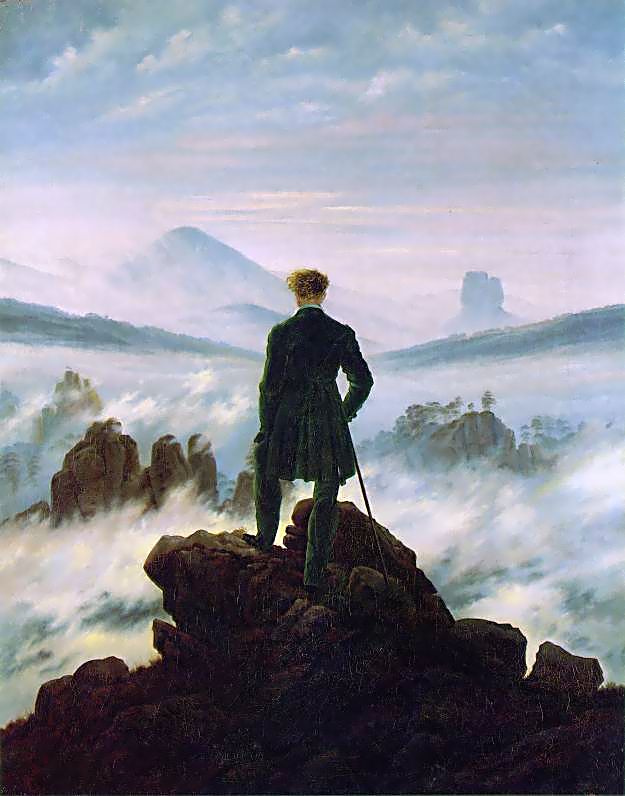 "Wanderer
above the Sea of Fog" by Caspar David Friedrich)
"Wanderer
above the Sea of Fog" by Caspar David Friedrich)
M 9-9 (William Wordsworth, pg 280-282, 310-314, 316, 318, 345-346)
Romantic Era Music by Women: Clara
Wieck Schumann (Trio in G
Minor Op. 17) & Fanny Mendelssohn Hensel (Easter
Sonata, she often published under brother's name Felix Mendelssohn)
Review Romanticism Quiz:
https://digital.wwnorton.com/42440
Introduction to Romanticism (PowerPoint Slides #19-22)
Pandaemonium (Wordsworth & Coleridge) movie (stop at 23:35):
("Frost at Midnight" pg 482 by Coleridge, 20:29 min to 23:35 min)
Hmwk: (1) Try listening to this while you write:
https://www.classicalradio.com/romanticperiod
(2)
response #1
and rubric
-- Submit it to either D2L or Turnitin.com
(Class ID 22025419, passcode key 2122D)
if interested in reading:
Student
Sample #2 and if need MLA help (scroll through
OWL PowerPoint or Check out this
Guide)
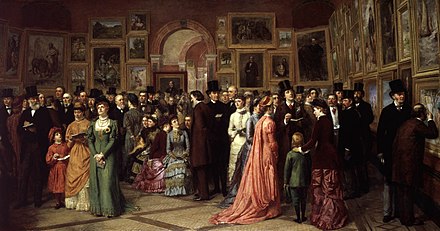 "A
Private View at the Royal Academy" by William Powell Frith
"A
Private View at the Royal Academy" by William Powell Frith
W 9-11 (Victorian Era, Introduction pg 3-16 & John Stuart Mill's "What is
Poetry?" pg 74-81 & can compare this to
"What is a Poet" by Wordsworth pg 310-314 from Romantic
book)
Response Paper #1 DUE
Victorian Age Music: Elgar's Chanson de Matin, Op. 15, No. 2:
https://www.youtube.com/watch?v=9s50XAbh7ro&list=PLeZIaxNYztJ8jSJm-kW2mb-3HeyNrnAkH
Victorian Age (Mr Osborne, 8 min):
https://www.youtube.com/watch?v=iBG6-BtCnxQ
Activity:
Rotate with every student getting one line from William Wordsworth “I
wandered lonely as a cloud” (pg 345) - How might the next generation (the
Victorians) react to this?
Victorian Age PowerPoint (Slides #1-20)
Show a few minutes:
Unbelievable Ways
Victorians Caused their own Deaths in the Name of Progress: arsenic (toys,
green wallpapers), toxins in beauty products, corsets (breathing problems,
crushed organs, caused infections), gas lighting (cant smell leaks until folks
dropped dead), toys made out of lead (affects the brain, ADD, hyperactivity) and
7 Very Victorian Ways to Die
Hmwk: Tennyson intro (pages 142 – 145, 169-170)
M 9-16 (Alfred Lord Tennyson, pg 142-145, 245, "The
Charge of the Light Brigade" (page 221-222), pg 169-170 - 2 excerpts from The
Princess, a feminist poem), if time
Charge of the Light Brigade movie (9 min scene)
Biography Video (6 min)
Victorian Age Music: Mendelssohn - A Midsummer Night's Dream: Overture
Tennyson's final poem: "Crossing the Bar" (page 245,
often sung, such as here by
The
Longest Johns 4 min or
The Altar of Praise Chorale 3 min)
Victorian PowerPoint: Slides 51-60
*You will need this day to see tips about doing the creative media project*
Extra information if interested:
excerpts from The Princess (a
feminist narrative poem, pg 169-170): "Now
Sleeps the Crimson Petal" 2 min & "Tears,
Idle Tears" 2 min (The poem tells the story of a heroic
princess who forswears the world of men and founds a women's university where
men are forbidden to enter. The prince to whom she was betrothed in infancy
enters the university with two friends, disguised as women students. They are
discovered and flee, but eventually they fight a battle for the princess's hand.
They lose and are wounded, but the women nurse the men back to health.
Eventually the princess returns the prince's love.) If you are brave, here is an
excerpt of actress singing Tennyson in
Vanity Fair
movie!
Hmwk: Elizabeth Barrett Browning (pages 109-110, 116 “Sonnets from the
Portuguese #43”) and if did not do last time: Tennyson intro (pages 142
– 145,
biography video 6 min)
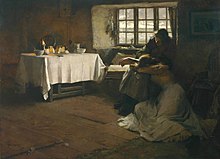 "A
Hopeless Dawn" by Frank Bramley
"A
Hopeless Dawn" by Frank Bramley
 W 9-18 (Elizabeth Barrett
Tennyson & Browning
Quiz #5&6, Browning,
Famous Love Poem: "Sonnet from the Portuguese #43" pg 116),
"Sonnet from the Portuguese #43"
(1 min, read by Judi Dench) pg 116 &
Mr Bruff’s
Analysis of Sonnet 43),
W 9-18 (Elizabeth Barrett
Tennyson & Browning
Quiz #5&6, Browning,
Famous Love Poem: "Sonnet from the Portuguese #43" pg 116),
"Sonnet from the Portuguese #43"
(1 min, read by Judi Dench) pg 116 &
Mr Bruff’s
Analysis of Sonnet 43),
Victorian PowerPoint (Slide #61-67),
Poem that helped change perspective and conditions,
Poor Law Act of 1834 (believed it would reduce cost of
caring for poor, take beggars from streets, but not exactly):
"The Cry of the Children" pg 110-114 (play both
at the same time -
this for audio:
& the 1912 Silent Film
by Thanhouser Film Corporation 5:45 to 7:45 min & 20:00 to 25:00 min
OR this for visual
- STANZA SIX) -
also see "First Report of the Commissioners, Mines" on page 634-635
"A
Dead Rose" (3 min, notice the changes from Burns and Blake with the image of
the rose)
Hmwk: Charles Dickens (pg 261-263) & A Christmas Carol (pg 264-274 -
end after first stave)
M 9-23 (Charles Dickens,
pg 261-263, A Christmas Carol pg 264-320)
Biography (4 min cartoon)
Review of Victorian Era (https://digital.wwnorton.com/18557)
Victorian PowerPoint (slide #40-49)
A Christmas Carol
(pg 272- 276)
watch (10 min about wife to get better understanding of author):
https://www.youtube.com/watch?v=YhbQo83IqmI
Hmwk: A Christmas Carol (pg 315-320 read stave five and
choose either stave two or stave three or stave
four-- be prepared to discuss your stave choice)
 "Charles
Dickens" by Daniel Maclise
"Charles
Dickens" by Daniel Maclise
W 9-25
Quiz #7: Review
Victorian Quiz
Share which Stave (2 or 3 or 4) you read
Go over
Creative Video Project
and
Rubric and SignUp Day
(available after today's after class!!)
Discuss the 3 Ghosts & how the story fits the gothic genre and review
quiz 8 on
Charles
Dickens A Christmas Carol
Watch
How Dickens
changed Christmas (5 min) to what we know today (sometimes called The Man
Who Invented Christmas) or
10 Things You didnt know about Dickens (4.5 min)
If time, watch: Analysis of some dialogue from book using something other
than PowerPoint (start at 1:20):
https://www.youtube.com/watch?v=W2sb4BUiFBs&t=211s
Hmwk: The Speckled Band by Arthur Conan Doyle (pg 920-921 & 921-938),
and you must also go to
Signup.com and pick one of the topic choices! Remember you can partner up
for the creative visual portion but only one person needs to go
to Signup.com to do so! (The written Response Portion should still be done
individually!)
Thursday September
26 – 6:30 PM Gordon Recital Series – Ashu – Saxophone
__________________________________________________________________End
Midterm Coverage______________________________________________
M 9-30 Arthur Conan Doyle (920-938)
What do we know about Doyle? What do we know about
Sherlock?
Review over "The
Speckled Band" or watch the 30 minute
LearnEnglish Cartoon
Who is the real Sherlock
Holmes? (5 min) - Compare the literary version vs the iconic film version as
we know him today
Chase Hughes
Prezzi Creation (Theme, Plot)
Vincent Fontaine's
Creative Media Creation (2 min)
The Scotsman
Creative Media Creation (2 min)
if did not get to last time:
Quiz #10: Charles Dickens A Christmas
Carol
Hmwk: work on creative video project (make sure you get your partner's
email and text number if you have a partner!)
and if not done so then go to
Signup.com to pick one of the remaining topic choices!
W 10-2 MIDTERM REVIEW DAY
This is the Romantics and the Victorians (not including Doyle, Houseman, or
Fields)
Review for upcoming test in class with
Kahoot
Victorian PowerPoint (Slide #24-35, feminism, "the Woman Question", "Angel in
the House")
Hmwk: work on creative video project and meet next class in IC 108
Some
examples:
"She Walks in Beauty"
by Lord Byron (created by PowToons)
"A
Prayer for my Daughter" by William Butler Yeats (4 min creative media
project)
"The Tygre"
by William Blake (2 min creative media project)
"Kubla Khan"
by Samuel T. Coleridge (odd version but creative)
Vincent Fontaine's
Creative Media Creation (2 min, created by mysimpleshow))
The Scotsman
Creative Media Creation (2 min)
M 10-7
Computer Lab:
Room IC 108
Work in
Class on
Creative Video Project
and
Rubric
and
check
SignUp Day (available after 9-25's after
class!!)
(bring
USB or mail saved work to yourself – do not save
on school computer!) *Good time to get
opinions from other students and me on your
Creative Media Project*
Hmwk:
complete work on
Creative Video Project
(Rubric
and if need to check
SignUp Day)
W 10-9
(A.
E. Housman
-- Modern
&
Michael Field
-- Victorian)
20th
Century PowerPoint (Slides #1-11)
From A Shophire Lad ("Blue
Remembered Hills") -
Peter Hitchens video (2 min) Poem 2
A.E.
Housman: "To
an Athlete Dying Young"
Poem 1
Two
videos: 2 min.
Tribute to Paul Walker (Fast &
Furious star)
Rob
Scotlan Video of
Housman’s famous poem (5 min)
Brendan Toohey Video of
Housman's famous poem (5 min)
Michael Field
(2 min) is pseudonym of two women
(Katharine Bradley & Edith Cooper, pages
761-763) & Alexis Coe's "The
Forgotten Scandalous Lesbian Writing Duo":
"A
Summer Wind" & "Nests
in Elms"
HMWK: **All Papers and Visuals DUE** next class
OCT 10 Last Day to WITHDRAW
M 10-14
**All Papers and Visuals DUE**
We will begin with a warm up to practice the
quiz on with:
A. E. Housman's
"When
I was One and Twenty" (1 min, created
by Motivation Maniac)
PowerPoint Slides #12-16
Quiz
#11 & #12 on other students Creative Video
Project
Viewing of your Creative Media Projects
(you must be here for both days even if you go
today!)
Hmwk:
none, unless you have not yet presented than
bring your presentation to class prepared to
present!
W 10-16
(last day for projects)
Quiz
#13 & #14 on other students Creative Video
Project
Viewing of your Creative Media Projects
(you must be here for both days even if you go
today!)
Hmwk:
study for Midterm a week from today (if needed
review
Romanticism)
study
(yes, study!) for Midterm on next Monday
Romanticism Review:
Introduction (pages 3-22), Lord Byron (pages
608-611, 613, & "When
We Two Parted"),
William Blake (pages 122-125, 138, 139-140),
Samuel
Taylor Coleridge (pages 441-444, 464-466,
482-484), Gothic Poetry (pages 514-515), William
Wordsworth (pages 280-282, 310-314, 316, 318,
345-346): Documentary
Review
of Romanticism
(1 hour)
Victorian Review:
(pages 3-16,
Alfred
Lord Tennyson (pages 142-145, 245, "The
Charge of the Light Brigade",
pages 169-170),
Elizabeth
Barrett Browning (pages pg 109-110, "The
Cry of the Children" pg 110-114, "Sonnet from
the Portuguese #43" pg 116),
Charles
Dickens (pg 261-263, A
Christmas Carol pg 264-320), The
Woman Question (pg 653-655)
Don’t forget you have 2 PowerPoints, a
Kahoot, and a Study Guide (see above
paragraphs)!
M 10-21
(Florence Nightingale & Emily Bronte)
Bronte
poems:
"Shall Earth No More Inspire Thee", "Love and
Friendship", and "I'm Happiest When Most Away"
Questions
attached
Hmwk:
study for Midterm (if needed review
Romanticism)
study
(yes, study!) for Midterm on next Monday
Romanticism Review:
Introduction (pages 3-22), Lord Byron (pages
608-611, 613, & "When
We Two Parted"),
William Blake (pages 122-125, 138, 139-140),
Samuel
Taylor Coleridge (pages 441-444, 464-466,
482-484), Gothic Poetry (pages 514-515), William
Wordsworth (pages 280-282, 310-314, 316, 318,
345-346): Documentary
Review
of Romanticism
(1 hour)
Victorian Review:
(pages 3-16,
Alfred
Lord Tennyson (pages 142-145, 245, "The
Charge of the Light Brigade",
pages 169-170),
Elizabeth
Barrett Browning (pages pg 109-110, "The
Cry of the Children" pg 110-114, "Sonnet from
the Portuguese #43" pg 116),
Charles
Dickens (pg 261-263, A
Christmas Carol pg 264-320), The
Woman Question (pg 653-655)
Don’t forget you have 2 PowerPoints, a
Kahoot, and a Study Guide (see above
paragraphs)!
"women's
Canteen at Phoenix Works" by Flora Lion"Merry-Go-Round"
by Mark Gertler
W 10-23 MIDTERM TEST
Hmwk:
bring
phone/computer, pen and paper
 "women's
Canteen at Phoenix Works" by Flora Lion
"women's
Canteen at Phoenix Works" by Flora Lion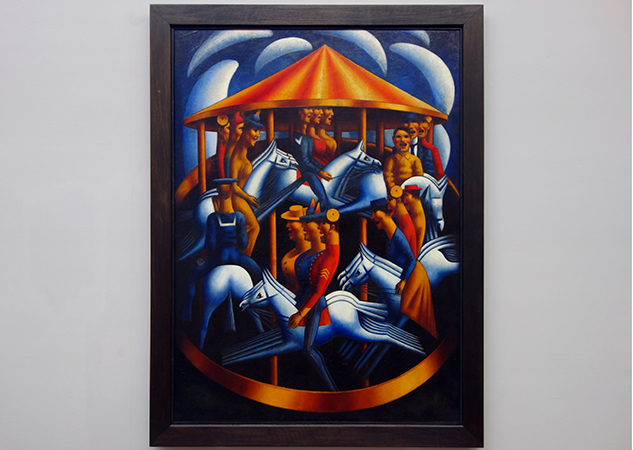 "Merry-Go-Round"
by Mark Gertler
"Merry-Go-Round"
by Mark Gertler
M 10-28
(WWI Poets)
Almost no musical work has had such a powerful
influence or evoked as much controversy as Igor
Stravinsky's ballet score “The
Rite of Spring” (2 min from Fantasia).
The work's premiere on May 29, 1913, at the
Théatre des Champs-Elysées in Paris, was
scandalous. There were riots!
In addition to the outrageous costumes, unusual
choreography and bizarre story of pagan
sacrifice, Stravinsky's musical innovations
upset the audience. Modernism had arrived.
review WW1 Poets PowerPoint Slides #21-40
(skip slides about poets until after jigsaw
activity)
More people died from
the
Spanish Influenza epidemic kills millions
worldwide. It is estimated that ten times as
many people died of the flu than were killed in
WWI. In fact,
half of U.S. soldiers who perished in Europe
died of the flu.
Quiz
#15 based on the following in class activity:
In
class Jigsaw activity: Get in groups and
discuss the author’s life and the assigned poem.
Look up any necessary information on your
phone/computer. Take notes! The note
portion counts as a quiz grade and will be
turned in, even if every member has the same
information written down. Look at what the poem
means, theme, metaphors, similes, and imagery.
Look at the author's life. Each member must turn in their own paper. You
will have 20 minutes! Please do not let one
person do all the work as this could result in
other members getting a zero even if they turn a
completed activity in. IMPORTANT: When
done, you will be assigned to a new group and as
an expert on your assigned poem you will have to
“report” to the new group on what you know! This
is done so that you can learn about the 4 major
poets from WW1 and these 6 poems but really only
doing the work to learn about 1 - killing six
birds with one stone!
Group 1:
Rupert
Brooke (pg 139 “The Solider”
but sometimes called "1914: the Solider")
Group 2:
Siegfried Sassoon (pg 148-149 “The
Rear-Guard”)
Group 3:
Siegfried Sassoon (pg 148-149 "Counter-Attack")
Group 4:
Isaac
Rosenberg (pg 155-157 “Break of Day in the
Trenches”)
Group 5:
Wilfred
Owen (pg 161 & 164 “Dulce Et Decorum Est”)
Group
6:
Wilfred
Owen "Anthem
for a Doomed Youth"
If
time, Myths about WW1 (10 min):
https://www.youtube.com/watch?v=zYvcfH_xYUs
Hmwk:
Yeats pg 209 – 212 and take this
take home test (bring questions and answers
to next class)
W 10-30
(William Butler Yeats)
finish WW1 Group Jigsaw activity from last class
if not completed
Take Home TEST #1 Due
William
Butler Yeats (5min reading of "When
You are Old"
Finish WW1 Propaganda PowerPoint Slide #40-49 &
P.E.E. for organizing response papers:
PowerPoint Slide #50-57
Yeats PowerPoint Slides #58-65
The 5 Yeats' poems:
“When
You Are Old” (page 216), watch this 15
minute video about “When
You Are Old”,
“Who
Goes With Fergus” (page 216), and "The
Song of Wandering Aengus"
“An Irish Airman Foresees his Death” (page
226),
“A
Prayer for my Daughter” (page 227-229) with
this 4
min creative media project video
Hmwk:
read "Araby"
by James Joyce and complete
Take Home TEST #2 (bring questions and
answers to next class)
optional documentary
No
Country for Old Men
(not the movie or book) about his end days
M 11-4
(James Joyce, 13 minute
boring bio, stop at 7 min)
finish Yeats "The
Isle of Innisfree" (his first great poem, a
nod to the Romantics, notice the lulling
rhythm?) and watch first 6 minutes of
The Passion of Yeats
Take Home TEST #2 due
PowerPoint #77-78
Is this
a trailer or the entire movie?:
https://www.youtube.com/watch?v=z3pUH1MfC9I
Read
aloud & discuss: “Araby” pg 407-411
if
time: Quiz
Review of story:
https://digital.wwnorton.com/42549
James
Joyce: The Annoying Epiphany Ending Explained (https://www.youtube.com/watch?v=inrGzEO6Yd0):
light imagery (2;50-4:10)
PowerPoint Slides # 1-12 (Post-Modernism PPT)
Trailer
(2 min) for "The
Dead" another story in The Dubliners
Hmwk:
Stevie Smith
“Not Waving but Drowning” pg 731, Stevie Smith
“Pretty” pg 733-734
-- compare to -- Margaret Atwood (author of
Handmaid’s Tale) “Miss July Grows Older”
pg 1123-1124 & "Habitation"
& "Crow's
Song", and Carol Ann Duffy
"Valentine"
& "War
Photographer" and then
Answer these questions.
EXTRA CREDIT OPPORTUNITY
Attend a showing of MacBeth and before
Monday class, turn in a copy of the ticket for
proof (cost is $5) and a
response
paragraph. The paragraph should prove you
actually watched it, mentioning your reaction
(good or bad) to things that happened on stage!
11-6 at 6pm, 11-7 & 11-8 & 11-9 at 730 pm,
11-10 at 2pm
W 11-6
(Stevie Smith & Margaret Atwood & Carol Ann
Duffy)
PowerPoint slides #13- 30 (Post-Modernism PPT)
Quiz 18
(from homework)
Review Extra Credit
Stevie Smith
“Not Waving but Drowning” pg 731, Stevie Smith
“Pretty” pg 733-734
-- compare to -- Margaret Atwood (author of
Handmaid’s Tale) “Miss July Grows Older”
pg 1123-1124 & "Habitation",
"Crow's
Song",
and Carol Ann Duffy
"Valentine"
(Creative
Media Project, 1.5 min compare to
Sana Chabaan's Project, 1.5 min) & "Text"
& "War
Photographer" (19 min
Mr Bruff Analysis or 2 min
Silent Annotation)and then
Answer these questions
from homework
Atwood Biography (4 min) - her first reading
was in a men's underwear section of a big
department store, she invented this pen that
auto-signs books, thinks bugs are delicious
Optional: photographer
Don McCullin (5 min)
Hmwk: none
M 11-11
(WWII Poets)
Extra Credit due (Pamphlet & Paragraph)
PowerPoint slides #66-74 (Modernism PPT)
WWII
Music:
https://www.youtube.com/watch?v=OfWc52smNs8&list=PLeulUC74_O8TfKoX2muaphFeCGZ3ms7qe&index=1
Quiz
#19 based on the following in class activity:
In
class Jigsaw activity: Get in groups and
discuss the author’s life and the assigned poem.
Look up any necessary information on your
phone/computer. Take notes! The note
portion counts as a quiz grade and will be
turned in, even if every member has the same
information written down. Look at what the poem
means, theme, metaphors, similes, and imagery.
Each member must turn in their own paper. You
will have 20 minutes!
Please do not let one
person do all the work as this could result in
other members getting a zero even if they turn a
completed activity in. IMPORTANT: When
done, you will be assigned to a new group and as
an expert on your assigned poem you will have to
“report” to the new group on what you know!
In 1854, the Crimean War began when Britain and
France declared war on Russia, and for
the next two years British, French, Sardinian,
and Turkish troops fought against Russians,
resulting in 1 650 000 soldiers dying.
In 1914, WW1 began, lasting for five years and
resulting in 16 million deaths of which 7
million were civilians.
In 1939, WW2 began, lasting for six years, and
resulting in
75 million deaths,
including 40 million civilians, many of whom
died because of deliberate genocide, massacres,
mass-bombings, disease, and starvation.
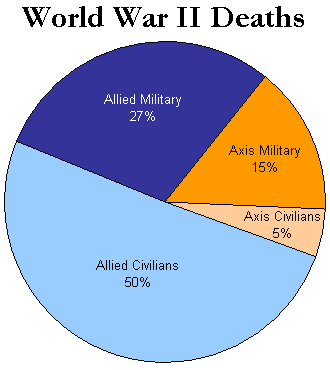
an estimated 70 million
people died -- over 4 times as many as in World
War I
Group 1:
Claude McCay "If
We Must Die" pg 855 (note when written)
Group 2:
Edith
Sitwell “Still Falls the Rain” pg 843-844
Group 3:
Alun Lewis "All
Day It Has Rained"
Group 4:
Thom
Gunn “Still Life” pg 940
Group 5: Sidney Keyes "Europe's
Prisoners"
Group 6: Sidney Keyes "War
Poet"
Group
7:
Keith Douglas "Vergissmeinnicht"
pg 846 (thought to have the most potential)
Group 8: Keith Douglas "Desert
Flowers" (Note the nod to WW1 poet
Rosenberg)
Group 9:
Henry Reed "Naming
of Parts" pg 844
Group 10:Ephim
Fogel "Shipment
to Maidanek" (Holocaust)
Group 11:
Dylan Thomas "The
Hand that Signed the Paper" (short but a bit
more challenging because of the references)
If
time, Propaganda film by Disney about WW2 (10
min):
https://www.youtube.com/watch?v=6vLrTNKk89Q
Hmwk: Hilary Mantel's "Winter
Break" 1) Describe the wife. 2) Describe the husband. 3) What is the
setting? 4) What does the wife imagine the bundle is that the taxi driver puts
into the trunk? 5) What is the twist ending? 6) Why do you think she is in
denial? 7) Do you think these characters are kind and good people? 8) Pick
either symbolism or tone or theme or character, then show an example/quote from
the text that illustrates one of these literary elements used by Mantel. 9) What
makes this story modern? Optional: You may also want to take a look at upcoming
Paper #3:
see
topic choices
and P.E.E. and
rubric
W
11-13 (Dylan Thomas & Hilary Mantel)
bio: Isa Goldberg's 5 min
Creative Media Project
PowerPoint Post-Modern slides # 31-37 (Thomas)
review
his biography and examine Dylan
Thomas “Do Not Go Gentle into That Good Night”
pg 833
"And Death Shall Have No Dominion" by Dylan Thomas:
"Do Not Go Gently into that Good Night" (villanelle):
video
PowerPoint Post-Modern slides # 45-48 (Mantel)
go over homework, Mantel biography, story, & then if
not done: look at
both the
Rubric & topic choices (Kureishi, Duffy, Zadie Smith, Desai)
Mantel:
biography
"While historians are sometimes described as frustrated
novelists, Hilary Mantel describes herself as a frustrated historian: ‘I only
became a novelist because I thought I had missed my chance to become a
historian. So it began as second best.’ When she was writing Wolf Hall,
she created a card index system to ensure her cast of characters were in the
right place at the right time. But this does not mean that Mantel writes like a
historian. Mantel’s fiction captures the classic contradiction of the historical
novel: searching for veracity, truth and authenticity while all the time
questioning what we thought we knew about the past." But she is one of few
authors to win 2 Booker Prizes for Wolf Hall and for Bring Up
the Bodies. The other we are studying is Margaret Atwood (The Blind
Assassin is her first win & The Testament is her second win but
she did not win for her most famous work: Handmaid's Tale!)
review Hilary Mantel's "Winter
Break"
Hmwk: work on Response Paper 3 (Modern) -- see
topic choices
and P.E.E. and
rubric
M
11-18 (George Orwell)
In
Class Quiz & read aloud, focus on literary elements as puzzle pieces when
author putting together a story
Review
Post Modern vs Modernism: Slide # 2 & 53-54
PowerPoint Post-Modern Slides #38-44 (brief look at biography then
story then
Bio, 13 min)
Movie Trailer (1 min)
Think
about the Plot Structure (Slide #41), Symbolism, Theme, Tone, Setting
"Shooting
an Elephant" (pages 734-740) -- We will read together and look over literary elements
similar to essay #3)
Discuss the stories, their plots and themes, likes and dislikes
PowerPoint Slide: #79-82
Hmwk: work on Response Paper 3 (Modern) -- see
topic choices
and P.E.E. and
rubric
Choice 1 - Hanif Kureishi
(story, pg 1202-1209) “My
Son the Fanatic”
Choice 2: Carol Ann Duffy
(long poem, pg 1213-1216) "The
Christmas Truce"
Choice 3: Zadie White (story, pg 1238-1248) "Waiter's
Wife"
Choice 4:
Kiran Desai “The Sermon in the Guava Tree” (story, pg
1227-1236)
W 11-20 Kazuo Ishiguro
Bio:
Kazuo Ishiguro, in full
Sir Kazuo Ishiguro,
(born November 8, 1954, Nagasaki, Japan), Japanese-born British novelist
known for his lyrical tales of regret fused with subtle optimism. Ishiguro
is the son of Shizuo Ishiguro, a physical oceanographer, and his wife
Shizuko. At the age of five, Ishiguro and his family (including his two
sisters) left Japan and moved to Guildford, Surrey, as his father was
invited for research at the National Institute of Oceanography. In 2017 he
won
the Nobel Prize for Literature (1 min) for his works that
“uncovered the abyss beneath our illusory sense of connection with the
world.” In 1960 Ishiguro’s family immigrated to Great Britain, where he
attended the universities of Kent (B.A., 1978) and East Anglia (M.A., 1980).
Upon graduation he worked at a homeless charity and began to write in his
spare time. Ishiguro’s first novel,
A Pale
View of Hills (1982), details the postwar memories of Etsuko, a
Japanese woman trying to deal with the suicide of her daughter Keiko. Set in
an increasingly Westernized Japan following World War II,
An Artist of the Floating World (1986)
chronicles the life of elderly Masuji Ono, who reviews his past career as a
political artist of imperialist propaganda. Ishiguro’s Booker Prize-winning
The Remains of the Day (1989; film
1993) is a first-person narrative, the reminiscences of Stevens, an elderly
English butler whose prim mask of formality has shut him off from
understanding and intimacy. With the publication of
The Remains of the
Day, Ishiguro became one of the best-known European novelists at just
35 years of age.
"
A
Family Supper" (We will read together and look at the literary elements
within the story)
Hmwk: work on Response Paper 3 (Modern) -- see
topic choices
and P.E.E. and
rubric
Choice 1 - Hanif Kureishi
(story, pg 1202-1209) “My
Son the Fanatic”
Choice 2: Carol Ann Duffy
(long poem, pg 1213-1216) "The
Christmas Truce"
Choice 3: Zadie White (story, pg 1238-1248) "Waiter's
Wife"
Choice 4:
Kiran Desai “The Sermon in the Guava Tree” (story, pg
1227-1236)
Thursday November
21 – 6:30 PM Vocal Music Concert
F 11-22
****Response Paper 3 Due
by 6pm****
M 11-25 Thanksgiving
W 11-27 Thanksgiving
M 12-2
(Modern Review)
finish PowerPoint Slide # 83-85
10
Things to Know about Adichie (10 min)
Review difference between Romanticism vs Victorian Era vs
Modernism vs Post-Modernism
Review of 20th Century
https://digital.wwnorton.com/42446
Hmwk:
Read
Chimaamanda Ngozi Adichie “Checking Out” (pg 1250 – 1262)
and complete
Take Home Test #3
W 12-4
(Chimaamanda Ngozi Adichie)
Take Home Test #3 due
Chimaamanda Ngozi Adichie “The Danger of a Single Story” TED Talk (30 min)
Discuss immigration and our views, bias, and how it relates to the literature we
read.
Chimaamanda Ngozi Adichie “Checking Out” (pg 1250 – 1262)
Read and discuss
Let's
think about:
1. Explain in a few sentences with examples: Something you learned in 2122.
2. Explain in a few sentences with examples: Something you think could be
improved or explained better/more in 2122 or something you want to know more
about).
3. What are the differences between Romanticism and Victorianism and
Modernism?
4. How does Chimaamanda Adichie's story "Checking Out" demonstrate the
development of British literature and British ideals from Romanticism
through Victorianism to Modernism?
M 12-9 Modern & Victorian Kahoot
review for final, discuss 2 choices for FINAL (home option: essay on Adichie
story due by 12-12 at 12:12pm to
turnitin.com & not minute later or will zero or class option: midterm format)
In class test will cover Doyle to Adichie, including theme, setting,
alliteration, symbolism, personification,
tone, epiphany, sonnet, octave and sestet, character, villanelle, and the
final
will focus on these works)
Th 12-12
FINAL 1015am-1215pm
![]()


 "Romantic
Landscape with Ruined Tower" by Thomas Cole
"Romantic
Landscape with Ruined Tower" by Thomas Cole  "The
Fall of the Rhine at Schaffhausen" by Philippe Jacques De Loutherbourg
"The
Fall of the Rhine at Schaffhausen" by Philippe Jacques De Loutherbourg
 "Wanderer
above the Sea of Fog" by Caspar David Friedrich)
"Wanderer
above the Sea of Fog" by Caspar David Friedrich)
 "A
Hopeless Dawn" by Frank Bramley
"A
Hopeless Dawn" by Frank Bramley W 9-18
W 9-18
 "women's
Canteen at Phoenix Works" by Flora Lion
"women's
Canteen at Phoenix Works" by Flora Lion
